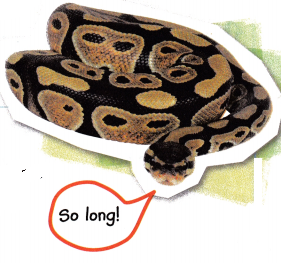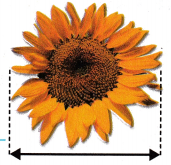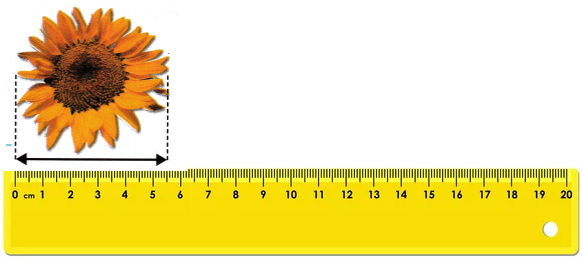All the solutions provided in McGraw Hill My Math Grade 5 Answer Key PDF Chapter 11 Lesson 10 Convert Metric Units of Length will give you a clear idea of the concepts.
McGraw-Hill My Math Grade 5 Answer Key Chapter 11 Lesson 10 Convert Metric Units of Length
The metric system is a decimal system of measurement. To convert metric units, multiply or divide by powers of 10.
Math in My World
Example 1
One of the largest recorded pythons measured 7.3 meters long. What is the length of the python in centimetres?

Convert 7.3 meters to centimetres.
Since 1 meter = 100 centimeters, multiply 7.3 by 100.

So, 7.3 meters = ______________ centimeters.
The python is ______________ centimeters long.
Answer:
The conversion of measurement from meters to centimetres can be done by multiplying the number of meters by 100. We know that one centimetre is equal to hundred centimetres, i.e., 1 m = 100 cm.

so, 7.3 metres = 730 centimetres
The python is 730 centimetres long.
Example 2
Roshonda has 50 dominoes. Each domino is 4 centimetres long. She lines them up end to end as shown. How many meters long is the line of dominoes?

1. Find the length in centimetres.
50 × 4 centimeters = _____________ centimeters

2. Convert ______________ centimeters to meters.
Since 1 meter = ______________ centimeters, divide ______________ by ______________.
So, ______________ centimeters = ______________ meters.
The line of 50 dominoes is ______________ meters long.
Answer:
The above-given:
1. The number of dominoes Roshonda has = 50
The number of centimetres long = 4
To find the length we need to multiply
length = 50 x 4 = 200 centimetres.
2. To convert 200 cms to metres
since, 1metre = 100 cms, divide 200 by 100
How to convert cms to metres:
1 centimetre is equal to 0.01 metres. To convert cms to metres, multiply the centimetre value by 0.01 or divide by 100.
centimetres to metres formula:
metre = cm * 0.01 (or) metre = cm / 100
200 / 100 = 2
so, 200 cms = 2 metres.
Therefore, the line of 50 dominoes is 2 metres long.
Talk Math
How can you use mental math to convert 7.38 kilometres to meters?

Answer:
Kilometre: A kilometre is a unit of Length or Distance in the Metric System. The symbol for kilometre is km. There are 0.001 kilometres in a meter.
Metre: A meter is a unit of Length or Distance in the Metric System. The symbol for the meter is m. There are 1,000 meters in a kilometre.
As we know, 1 kilometre = 1000 metres
Conversion formula:
The formula to convert from km to m is:
metre = kilometre x 1000
The above-given kilometre is 7.38
Now apply the formula:
metre = 7.38 x 1000
metre = 7,380.
Guided Practice
Complete
Question 1.
5 m = ![]() cm
cm
5 × 100 = ______________
So, 5 meters equals ____________ centimeters.
Answer:
The conversion of measurement from meters to centimetres can be done by multiplying the number of meters by 100. We know that one centimetre is equal to hundred centimetres, i.e., 1 m = 100 cm.
The above-given:
5 m is equal to how many cms.
5 metres = 5 x 100 = 500
Therefore, 5 metres equals 500 centimetres.
Question 2.
9,000 m= ![]() km
km
9,000 ÷ 1,000 = ____________
So, 9,000 meters equals _____________ kilometers.
Answer:
– A kilometer is a unit of distance in International System of units (SI). It is denoted by km. Km is usually used to express the distance of places or land.
1 km = 1000 m
– A meter is also unit of distance as well as length. It is a SI unit denoted by ‘m’. Meter is used to express distance and length of objects.
1 M = 1/1000 Km
9000 m = 9000 / 1000
9000 m = 9 kilometres
Therefore, 9000 metres is equal to 9 kilometres.
Independent Practice
Complete.
Question 3.
700 cm = _______________ m
Answer: 7 metres
Explanation:
How to convert cms to metres
1 centimetre is equal to 0.01 meters:
1 cm = 0.01 metres
The distance d in meters (m) is equal to the distance d in centimetres (cm) divided by 100:
d(m) = d(cm) / 100
d(m) = 700 / 100
d(m) = 7
Therefore, 700 centimetres is equal to 7 metres.
Question 4.
8,500 mm = _______________ m
Answer: 8.5 metres
Explanation:
How to convert millimetres to metres
1 millimetre is equal to 0.001 meters:
1 mm = 0.001 m
The distance d in meters (m) is equal to the distance d in millimeters (mm) divided by 1000:
d(m) = d(mm) / 1000
d(m) = 8500 / 1000
d(m) = 8.5
Therefore, 8500 mm is equal to 8.5 m.
Question 5.
15 km = _______________ m
Answer: 1500 metres
Explanation:
How to convert kilometre to metre
1 kilometre is equal to 1000 meters:
1 km = 1000 m
The distance d in meters (m) is equal to the distance d in kilometres (km) times 1000:
d(m) = d(km) x 1000
d(m) = 15 x 1000
d(m) = 1500
Therefore, 15 km is equal to 1500 metres.
Question 6.
73,000 m = _______________ km
Answer: 73 km
Explanation:
How to convert metres to kilometres
1 kilometre is equal to 1000 meters:
1 km = 1000 m
The distance d in kilometres (km) is equal to the distance d in meters (m) divided by 1000:
d(km) = d(m) / 1000
d(km) = 73000 / 1000
d(km) = 73
Therefore, 73000 metres is equal to 73 kilometres.
Question 7.
2.71 m = _______________ mm
Answer: 2710 mm
Explanation:
How to convert metres to millimetres:
1 meter is equal to 1000 millimetres:
1 m = 1000 mm
The distance d in millimetres (mm) is equal to the distance d in meters (m) times 1000:
d(mm) = d(m) x 1000
d(mm) = 2.71 x 1000
d(mm) = 2710
Therefore, 2.71 metres is equal to 2710 millimetres.
Question 8.
9.2 m = _______________ cm
Answer: 920 cm
Explanation:
How to convert metres to centimetres:
1 meter is equal to 100 centimetres:
1 m = 100 cm
The distance d in centimetres (cm) is equal to the distance d in meters (m) times 100:
d(cm) = d(m) x 100
d(cm) = 9.2 x 100
d(cm) = 920
Therefore, 9.2 metres is equal to 920 centimetres.
Question 9.
17.5 mm = _______________ cm
Answer: 1.75 centimetres
Explanation:
How to convert mm to cm:
1 mm is equal to 0.1 centimetres:
1 mm = 0.1 cm
The distance d in centimetres (cm) is equal to the distance d in millimetres (mm) divided by 10:
d(cm) = d(mm) / 10
d(cm) = 17.5 / 10
d(cm) = 1.75
Therefore, 17.5 mm is equal to 1.75 centimetres.
Question 10.
0.509 km = _______________ m
Answer: 509 metres
Explanation:
How to convert kilometres to metres:
1 kilometre is equal to 1000 meters:
1 km = 1000 m
The distance d in meters (m) is equal to the distance d in kilometres (km) times 1000:
d(m) = d(km) x 1000
d(m) = 0.509 x 1000
d(m) = 509
Therefore, 0.509 kilometres is equal to 509 metres.
Complete. Use <, >, or = to make a true statement.
Question 11.
30 cm ![]() 300 mm
300 mm
Answer: equal to
Explanation:
How to convert cm to mm:
1 centimetre is equal to 10 millimetres:
1 cm = 10 mm
The distance d in millimetres (mm) is equal to the distance d in centimetres (cm) times 10:
d(mm) = d(cm) x 10
d(mm) = 30 x 10
d(mm) = 300
We conclude that 30 centimeters is equivalent to 300 millimeters: 30 centimeters = 300 millimeters.
Question 12.
4.8 km ![]() 4,800 m
4,800 m
Answer: equal to (=)
Explanation:
How to convert km to m:
1 kilometre is equal to 1000 meters:
1 km = 1000 m
The distance d in meters (m) is equal to the distance d in kilometres (km) times 1000:
d(m) = d(km) x 1000
d(m) = 4.8 x 1000
d(m) = 4800
We conclude that 4.8 kilometres are equivalent to 4800 meters: 4.8 kilometres = 4800 meters.
Question 13.
25 mm ![]() 3 cm
3 cm
Answer: less than (<)
Explanation:
A millimetre is smaller than a centimetre. Simply put, mm is smaller than cm.
Therefore, we can conclude that 25 mm is less than 3 cm
Question 14.
9 km ![]() 8,500 m
8,500 m
Answer: greater than (>)
Kilometres are 1,000 times larger than meters. The meter is the base unit for measuring length or distance in the metric system.
– According to the above statement we can easily conclude that 9 km is greater than 8500 m.
Question 15.
1.5 m ![]() 145 cm
145 cm
Answer: greater than (>)
Explanation:
One meter is equal to 100 centimetres:
1m = 100×1m = 100cm
1.5 m = 1.5 x 100 = 150
It is 1.5 m because 145 cm = 1.45 m; 1.5 m equals 150 cm which is greater than 145 cm.
Question 16.
17 m ![]() 116 cm
116 cm
Answer: greater than (>)
1 meter is equal to 100 centimetres:
1m = 100×1m = 100cm
17 m = 17 x 100 = 1700 cm
Finally, 17 m = 1700 cm which is larger than 116 cm
Therefore, 17 metres is equal to 116 cms.
Problem Solving
Question 17.
Measure the distance across the sunflower to the nearest centimetre. How many centimetres shorter than 1 meter is the width of the sunflower?

Answer:
The nearest centimetre is 5

1 meter is equal to 100 centimetres:
1 m = 100 cms
The number of centimetres shorter than 1 meter is the width of the sunflower = x
x = 100 – 5
x = 95 cms
Therefore, 95 cms shorter.
Question 18.
Mathematical PRACTICE Check for Reasonableness Which is the most reasonable estimate for the depth of a lake: 6 millimetres, 6 centimetres, or 6 meters? Explain.
Answer:
6 metres is large both 6 mm and 6 cm are too small.
Question 19.
A spider is 6 millimetres long. What fractional part of 1 centimetre is 6 millimetres?

Answer:
The length of a spider = 6mm
1 mm is equal to 0.1 centimetres:
1 mm = 0.1 cm
The distance d in centimetres (cm) is equal to the distance d in millimetres (mm) divided by 10:
d(cm) = d(mm) / 10
d(cm) = 6 / 10
d(cm) = 0.6
HOT Problems
Question 20.
Mathematical PRACTICE Which One Doesn’t Belong? Circle the measure that does not belong with the other three. Explain your reasoning.

Answer:

Explanation:
3.5 m convert to mm
1 meter is equal to 1000 millimetres:
1 m = 1000 mm
The distance d in millimetres (mm) is equal to the distance d in meters (m) times 1000:
d(mm) = d(m) x 1000
d(mm) = 3.5 x 1000
d(mm) = 3500mm
Now convert metres to cms:
1 meter is equal to 100 centimetres:
1 m = 100 cms
The distance d in centimetres (cm) is equal to the distance d in meters (m) times 100:
d(cm) = d(m) x 100
d(cm) = 3.5 x 100
d(cm) = 350 cm
Now convert km to m:
1 kilometre is equal to 1000 meters:
1 km = 1000 m
The distance d in meters (m) is equal to the distance d in kilometres (km) times 1000:
d(m) = d(km) x 1000
d(m) = 3500 x 1000
d(m) = 3500000m
Question 21.
Building on the Essential Question Compare and contrast converting customary units of length and converting metric units of length.
Answer:
To convert customary units, you multiply or divide by 10.
To convert metric units, you multiply or divide by powers of 10.
McGraw Hill My Math Grade 5 Chapter 11 Lesson 10 My Homework Answer Key
Practice
Complete.
Question 1.
300 cm = _________________ m
Answer: 3 metres
Explanation:
How to convert centimetres to metres:
1 centimetre is equal to 0.01 meters:
1 cm = 0.01 metres
The distance d in meters (m) is equal to the distance d in centimetres (cm) divided by 100:
d(m) = d(cm) / 100
d(m) = 300 / 100
d(m) = 3
Therefore, 300 cm is equal to 3 metres.
Question 2.
500 mm = _________________ cm
Answer: 50 cms
Explanation:
How to convert millimetre to centimetre:
1 mm is equal to 0.1 centimetres:
1 mm = 0.1 cms
The distance d in centimetres (cm) is equal to the distance d in millimetres (mm) divided by 10:
d(cm) = d(mm) / 10
d(cm) = 500 / 10
d(cm) = 50
Therefore, 500 mm is equal to 50 cm.
Question 3.
1.7 km = _________________ cm
Answer: 170000cm
How to convert km to cm:
1 kilometre is equal to 100000 centimetres:
1 km = 100000 cm
The distance d in centimetres (cm) is equal to the distance d in kilometres (km) times 100000:
d(cm) = d(km) x 100000
d(cm) = 1.7 x 100000
d(cm) = 170000
Therefore, 1.7 km is equal to 170000.
Question 4.
2 km = _________________ m
Answer: 2000 metres
Explanation:
1 kilometre is equal to 1000 meters:
1 km = 1000 m
The distance d in meters (m) is equal to the distance d in kilometres (km) times 1000:
d(m) = d(km) x 1000
d(m) = 2 x 1000
d(m) = 2000
Therefore, 2 km is equal to 2000 metres.
Question 5.
6 cm = _________________ mm
Answer: 60 mm
Explanation:
How to convert centimetres to millimetres:
1 centimetre is equal to 10 millimetres:
1 cm = 10 mm
The distance d in millimetres (mm) is equal to the distance d in centimetres (cm) times 10:
d(mm) = d(cm) x 10
d(mm) = 6 x 10
d(mm) = 60
Therefore, 6 cm is equal to 60 millimetres.
Question 6.
238 cm = _________________ m
Answer: 2.38 m
Explanation:
How to convert centimetres to metres:
1 centimetre is equal to 0.01 meters:
1 cm = 0.01 m
The distance d in meters (m) is equal to the distance d in centimetres (cm) divided by 100:
d(m) = d(cm) / 100
d(m) = 238 / 100
d(m) = 2.38
Therefore, 238 cm is equal to 2.38 metres.
Question 7.
2,400 mm = _________________ m
Answer: 2.4 metres
Explanation:
How to convert millimetres to metres:
1 millimetre is equal to 0.001 meters:
1 mm = 0.001 m
The distance d in meters (m) is equal to the distance d in millimetres (mm) divided by 1000:
d(m) = d(mm) / 1000
d(m) = 2400 / 1000
d(m) = 24 / 10
d(m) = 2.4
Therefore, 2400 mm is equal to 2.4 metres.
Question 8.
175 mm = _________________ m
Answer: 0.175 metres
Explanation:
How to convert millimetres to metres:
1 millimetre is equal to 0.001 meters:
1 mm = 0.001 m
The distance d in meters (m) is equal to the distance d in millimetres (mm) divided by 1000:
d(m) = d(mm) / 1000
d(m) = 175 / 1000
d(m) = 0.175
Therefore, 175 mm is equal to 0.175 metres.
Problem Solving
Question 9.
When completed, a tunnel will be 1,500 meters long. What is this length in kilometres?
Answer: 1.5 kilometres
Explanation:
The length of a tunnel = 1500 m
We need to find out the length in kilometres:
How to convert metres to kilometres:
1 kilometre is equal to 1000 meters:
1 km = 1000 m
The distance d in kilometres (km) is equal to the distance d in meters (m) divided by 1000:
d(km) = d(m) / 1000
d(km) = 1500 / 1000
d(km) = 1.5
Therefore, the length in kilometres is 1.5
Question 10.
Mathematical PRACTICE Use Number Sense The depth of a swimming pool is 8.5 meters. What is half of the depth in millimetres?
Answer:
The above-given:
The depth of the swimming pool is 8.5 m
Now first convert it into millimetres:
1 meter is equal to 1000 millimetres:
1 m = 1000 mm
The distance d in millimetres (mm) is equal to the distance d in meters (m) times 1000:
d(mm) = d(m) x 1000
d(mm) = 8.5 x 1000
d(mm) = 8500
In the question asked, half of the depth in millimetres:
8500 / 2 = 4250
Therefore, half of the depth is 4250 millimetres.
Vocabulary Check
Choose the correct word(s) that completes each sentence.
millimetre
centimetre
meter
kilometre
metric system
Question 11.
The ______________ is an appropriate unit to measure the length of a ladybug.
Answer: centimetre
Explanation:
The size of a ladybug is very small, of the order of centimetres. Thus centimetres is the best scale for measuring the length of a ladybug.
Question 12.
The ______________ is an appropriate unit to measure the distance between two cities.
Answer:
The most appropriate unit of the metric system for measuring the distance between two cities is kilometres. The standard unit of measurement in all countries is Metric therefore the distance between two cities or two towns is measured in Kilometres per hour.
Question 13.
The ______________ is a decimal system of measurement.
Answer:
The metric system is an international decimal system of measurement in Mathematics. It is a set of standard units defined to measure length, weight, area, and capacity. The metric system is based on the decimal system as it includes numbers in powers of 10.
Test Practice
Question 14.
Kaelyn is reading a book. The book’s thickness is 31 millimetres. Which is the correct thickness in centimetres?
(A) 3.001 centimeters
(B) 3.01 centimeters
(C) 3.1 centimeters
(D) 3.11 centimeters
Answer: Option C is correct.
Explanation:
The thickness of the book is 31 mm
In centimetres,
1 mm is equal to 0.1 centimetres:
1 mm = 0.1 cm
The distance d in centimetres (cm) is equal to the distance d in millimetres (mm) divided by 10:
d(cm) = d(mm) / 10
d(cm) = 31 / 10
d(cm) = 3.1
Therefore, the thickness of the book in centimetres is 3.1